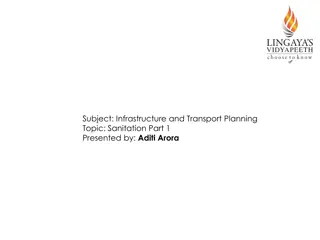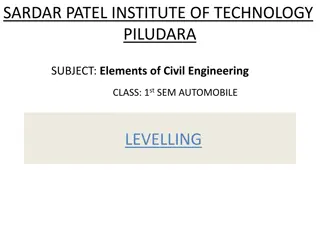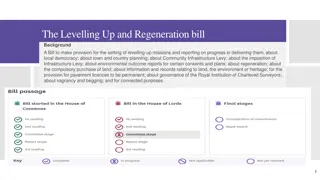Levelling Techniques for Urban Sanitation Improvement Projects
Explore the essential aspects of levelling, including setting benchmarks, calculating important levels for a DTF, reading cross-sectional drawings, and using optical levels. Understand the significance of benchmarks, backward calculations from discharge points, and individual level definitions for effective project management. Enhance your knowledge and skills for successful implementation in urban sanitation projects.
Download Presentation

Please find below an Image/Link to download the presentation.
The content on the website is provided AS IS for your information and personal use only. It may not be sold, licensed, or shared on other websites without obtaining consent from the author.If you encounter any issues during the download, it is possible that the publisher has removed the file from their server.
You are allowed to download the files provided on this website for personal or commercial use, subject to the condition that they are used lawfully. All files are the property of their respective owners.
The content on the website is provided AS IS for your information and personal use only. It may not be sold, licensed, or shared on other websites without obtaining consent from the author.
E N D
Presentation Transcript
Upscaling Basic Sanitation for the Urban Poor (UBSUP) Background information needed for the Levelling for a DTF 10/1/2024 1
Levelling In this session you learn: What is a benchmark and how to set it up? Which levels are determining the future set up of the DTF? What are the important levels for a DTF? How to read the cross-sectional drawings? How to level with the collimation method? Group work 10/1/2024 2
What is a benchmark? A benchmark is a fixed reference point which does not change during the entire project time Usually defined at 100,000m altitude Should be visible from all points of the construction side All existing and future level points have to be calculated in reference to this reference point 10/1/2024 3
How to set up a benchmark? Choose a fixed point at an existing and permanent structure (e.g. electricity poste, existing building) or fix your own benchmark at the construction side. Concreted marker stone Electricity pole with a nail 10/1/2024 4
What are the important levels for a DTF? We have to calculate backwards from the effluent discharge point 3 4 1 2 1% 1% 1% RBBT 1% ST ABR VFCW 10/1/2024 5
How to read the cross-sectional drawings? Cross sectional drawings are provided in the next training for Design adaptation Level differences have to be defined individually by the DTF technical team depending on the positioning of the modules 10/1/2024 6
How to use the optical level? Introduction to the instrument Level the instrument by adjusting the levelling screws. The bubble to be central in the circle. Turn the telescope through 180 Parallax is the apparent movement of the cross-hairs over the levelling staff when the eye is moved up and down while sighting through the instrument. 10/1/2024 7
How to use the optical level? Introduction to the instrument Sight onto the levelling staff. Focus the telescope on the staff. Always ensure the bubble is central Take the reading of height. Each square is 1cm (10mm) First metre is black and second metre is red Each E is 100mm (0.1m) apart 10/1/2024 8
How to level with the collimation method The temporary benchmark and height of collimation Decide for an BM BM BM: Benchmark = 100,000 10/1/2024 9
How to level with the collimation method The temporary benchmark and height of collimation The booking of the levels is done at the same time the reading is taken Place the rod on top of the BM HoC =X No1= BM BM: Benchmark = 100,000 HoC: Height of Collimation = OBM + X 10/1/2024 10
How to level with the collimation method Rules of booking or the surveyor language After moving the optical level the booking procedure remains the same BS= Back Sight = the first reading from a new instrument position BS IS FS FS IS IS BS IS= Intermediate Sight= occurs between the Back Sight and Foresight FS= Foresight= is always the last reading from an instrument position 10/1/2024 11
How to level with the collimation method Rules of booking or the surveyor language HOC1=101,056 to be added in diagram HoC1= 100,000+1,056 FS IS IS BS 1,056 No.1: BM=100,000 BM is the first reduced level! 10/1/2024 12
How to level with the collimation method Rules of booking or the surveyor language No. Backsight (BS) Intermediate Sight (SI) Fore Sight (FS) Height of Collimation Reduced level (RL) Remarks 1 1,056 101,056 100,000 Benchmark First reduced level! Number it! Fill in first reading = height of optical level Name the reading 10/1/2024 13
How to level with the collimation method Rules of booking or the surveyor language HoC1= 100,000+1,056 FS IS IS BS 1,056 2,398 1,575 2,017 No.1= BM=100,000 No.4= 101,056-1,575= 99,481 No.2= 101,056-2,017= 99,039 No.3= 101,056-2,398= 98,658 10/1/2024 14
How to level with the collimation method Diagram for booking readings minus No. Backsight (BS) Intermediate Sight (SI) Fore Sight (FS) Height of Collimation Reduced level (RL) Remarks 1 1,056 101,056 100,000 Benchmark 2 2,017 99,039 3 2,398 99,658 4 1,575 99,481 Change Point Fill readings into the diagram Leads to the reduced levels 10/1/2024 15
How to level with the collimation method Rules of booking or the surveyor language Rod must remain in the old position until the first reading from the new position has been completed! HoC2= HoC1-1,575+2,176=101,657 BS IS FS HoC1= 2,539 2,176 1,839 100,000+1,056 FS IS IS BS 1,056 2,398 1,575 2,017 No.1= BM=100,000 No.4= 101,056-1,575= 99,481 No.5= 101,657-1,839= 99,818 No.2= 101,056-2,017= 99,039 No.6 DP= 101,657-2,539= 99,118 No.3= 101,056-2,398= 98,658 10/1/2024 16
How to level with the collimation method Diagram for booking readings No. Backsight (BS) Intermediate Sight (SI) Fore Sight (FS) Height of Collimation Reduced level (RL) Remarks 1 1,056 101,056 100,000 Benchmark 2 2,017 99,039 3 2,398 99,658 4 2,176 1,575 101,657 99,481 Change Point 5 1,839 99,818 6 2,539 99,118 Discharge point Fill in the new readings Calculate the Height of collimation for the new position: HoC2= 101,056-1,575+2,176= 101,657 Reduced level (RL) for Discharge point= 101,657-2,539=99,118 10/1/2024 17
How to level with the collimation method Diagram for booking readings No. Backsight (BS) Intermediate Sight (SI) Fore Sight (FS) Height of Collimation Reduced level (RL) Remarks 1 1,056 101,056 100,000 Benchmark 2 2,017 99,039 ST 3 2,398 99,658 ABR 4 2,176 1.575 101,657 99,481 Change Point 5 1,839 99,818 VFCW 6 2,539 99,118 Discharge point 3,232 4,114 Calculation double check: F.S - B.S = first reduced level last reduced level Example: 4,114-3,232=100,000-99,118 0,882 = 0,882 10/1/2024 18
How to level with the collimation method Calculate the reduced level at the Discharge point (DP) HoC2= HoC1-FS+BS=? BS IS FS HoC1= BM+BS=? 2.78m 3.02m 2.67m FS IS IS BS 0.52m 2.56m 2.27m 2.45m BM=1,800.00m Transfer point=? ST outlet=? ABR outlet=? VFCW outlet=? DP=? 10/1/2024 19
How to level with the collimation method Calculate the reduced level at the Discharge point (DP) No. Backsight (BS) Intermediate Sight (SI) Fore Sight (FS) Height of Collimation Reduced level (RL) Remarks 1 0.52m 1,800.52m 1,800.00m Benchmark 2 2.45m 1,799.48m ST= 1,800.00-2.45 3 2.56m 1,797.44m ABR= 1,800.00-2.56 4 2.67m 2.27m 1,800.92m 1,798.14m Change Point 5 2.78m 1,798.14m VFCW 6 3.02m 1,797.90m Discharge point 3.19m 5.29m Double Check the calculation! Calculation double check: F.S - B.S = first reduced level last reduced level Example: 5.29m-3.19m=1,800.00m-1,797.90m 2.1m=2.1m 10/1/2024 20
Group Exercise within the DTF technical team : Time: 20min Type of exercise: group work of technical DTF team Transfer the example readings for BS, IS, FS into the booking diagram Calculate the reduced levels for OBM, Settler outlet, ABR, Temporary Benchmark, VFCW and Discharge Point Do a calculation double check 10/1/2024 21
How to level with the collimation method Diagram for booking readings No. Backsight (BS) Intermediate Sight (SI) Fore Sight (FS) Height of Collimation Reduced level (RL) Remarks 1 1.83 1,801.83 1,800.00 BM 2 0.89 1,800.94 RB outlet 3 2.49 1,799.34 ST outlet 4 2.06 3.27 1,800.62 1,798.57 ABR outlet / Ch- point 5 3.66 1,796.96 DP BS: FS: 10/1/2024 22
Do you have any questions, remarks or suggestions? 10/1/2024 23























